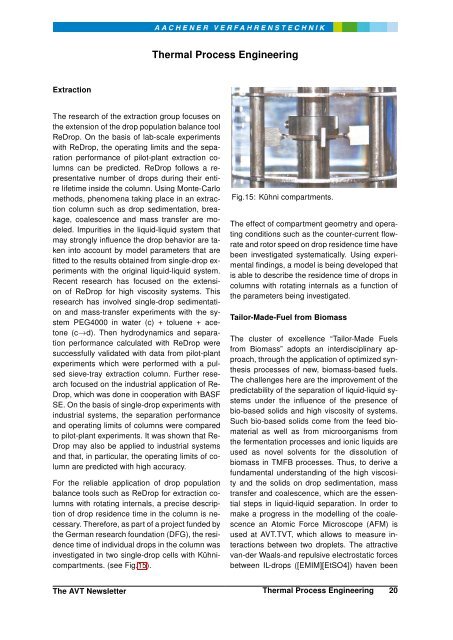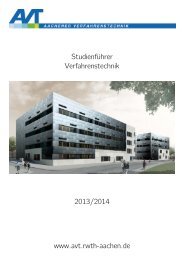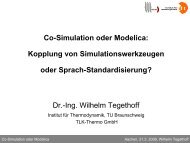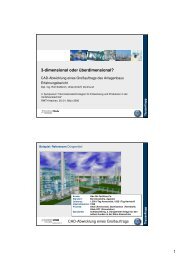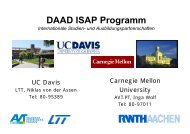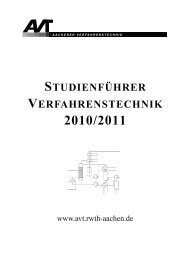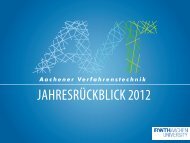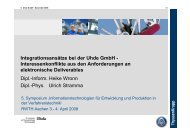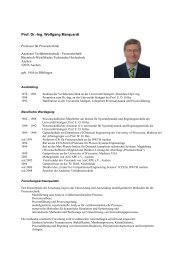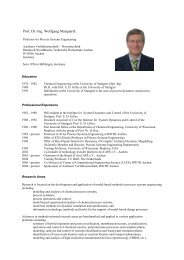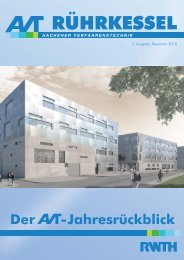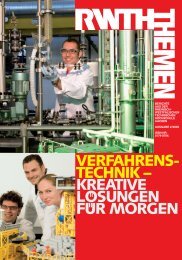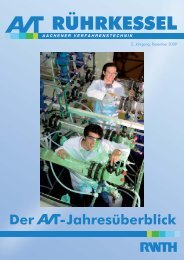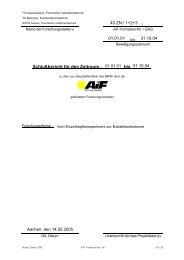Newsletter - Aachener Verfahrenstechnik - RWTH Aachen University
Newsletter - Aachener Verfahrenstechnik - RWTH Aachen University
Newsletter - Aachener Verfahrenstechnik - RWTH Aachen University
You also want an ePaper? Increase the reach of your titles
YUMPU automatically turns print PDFs into web optimized ePapers that Google loves.
Extraction<br />
The research of the extraction group focuses on<br />
the extension of the drop population balance tool<br />
ReDrop. On the basis of lab-scale experiments<br />
with ReDrop, the operating limits and the separation<br />
performance of pilot-plant extraction columns<br />
can be predicted. ReDrop follows a representative<br />
number of drops during their entire<br />
lifetime inside the column. Using Monte-Carlo<br />
methods, phenomena taking place in an extraction<br />
column such as drop sedimentation, breakage,<br />
coalescence and mass transfer are modeled.<br />
Impurities in the liquid-liquid system that<br />
may strongly influence the drop behavior are taken<br />
into account by model parameters that are<br />
fitted to the results obtained from single-drop experiments<br />
with the original liquid-liquid system.<br />
Recent research has focused on the extension<br />
of ReDrop for high viscosity systems. This<br />
research has involved single-drop sedimentation<br />
and mass-transfer experiments with the system<br />
PEG4000 in water (c) + toluene + acetone<br />
(c→d). Then hydrodynamics and separation<br />
performance calculated with ReDrop were<br />
successfully validated with data from pilot-plant<br />
experiments which were performed with a pulsed<br />
sieve-tray extraction column. Further research<br />
focused on the industrial application of Re-<br />
Drop, which was done in cooperation with BASF<br />
SE. On the basis of single-drop experiments with<br />
industrial systems, the separation performance<br />
and operating limits of columns were compared<br />
to pilot-plant experiments. It was shown that Re-<br />
Drop may also be applied to industrial systems<br />
and that, in particular, the operating limits of column<br />
are predicted with high accuracy.<br />
For the reliable application of drop population<br />
balance tools such as ReDrop for extraction columns<br />
with rotating internals, a precise description<br />
of drop residence time in the column is necessary.<br />
Therefore, as part of a project funded by<br />
the German research foundation (DFG), the residence<br />
time of individual drops in the column was<br />
investigated in two single-drop cells with Kühnicompartments.<br />
(see Fig.15).<br />
Thermal Process Engineering<br />
Fig.15: Kühni compartments.<br />
The effect of compartment geometry and operating<br />
conditions such as the counter-current flowrate<br />
and rotor speed on drop residence time have<br />
been investigated systematically. Using experimental<br />
findings, a model is being developed that<br />
is able to describe the residence time of drops in<br />
columns with rotating internals as a function of<br />
the parameters being investigated.<br />
Tailor-Made-Fuel from Biomass<br />
The cluster of excellence “Tailor-Made Fuels<br />
from Biomass” adopts an interdisciplinary approach,<br />
through the application of optimized synthesis<br />
processes of new, biomass-based fuels.<br />
The challenges here are the improvement of the<br />
predictability of the separation of liquid-liquid systems<br />
under the influence of the presence of<br />
bio-based solids and high viscosity of systems.<br />
Such bio-based solids come from the feed biomaterial<br />
as well as from microorganisms from<br />
the fermentation processes and ionic liquids are<br />
used as novel solvents for the dissolution of<br />
biomass in TMFB processes. Thus, to derive a<br />
fundamental understanding of the high viscosity<br />
and the solids on drop sedimentation, mass<br />
transfer and coalescence, which are the essential<br />
steps in liquid-liquid separation. In order to<br />
make a progress in the modelling of the coalescence<br />
an Atomic Force Microscope (AFM) is<br />
used at AVT.TVT, which allows to measure interactions<br />
between two droplets. The attractive<br />
van-der Waals-and repulsive electrostatic forces<br />
between IL-drops ([EMIM][EtSO4]) haven been<br />
The AVT <strong>Newsletter</strong> Thermal Process Engineering 20


